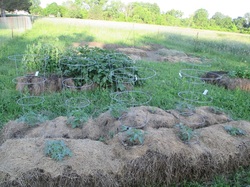 Our hay bale garden - first week of June.
Our hay bale garden - first week of June. Just to catch you up, last fall we found ourselves the proud owners of 20 bales of hay, given to us in "payment" by a neighbor for haying our field. While we do plan to add some grass-eating animals to the homestead eventually, right now we're still in the preparation stages.
So what to do with all this hay? I had seen videos about straw-bale gardening in the past, and had always found it intriguing, so I wondered if one could also garden in hay bales?
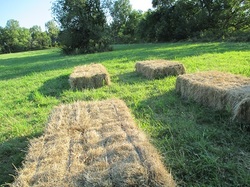 Hay bales laid out in the fall to rest.
Hay bales laid out in the fall to rest. Heck, I can deal with a few weeds, I thought, and laid out the bales in a semblance of beds at one end of our garden-to-be to start decomposing over the winter.
Fast forward 7 months to April, as I stared out the window gloomily at the rain, waiting...waiting...waiting...for it to stop.
Apparently, our land is composed of clay. It's also flat as a pancake, and has no drainage whatsoever. Visions of a beautiful garden had danced in my head all winter, and now they were withering on the vine as the weeks ticked by, and our garden space remained just short of a swamp. No digging, bed preparation, or planting was possible....
But wait! We have 4 large 18"-high "beds" made of hay bales!
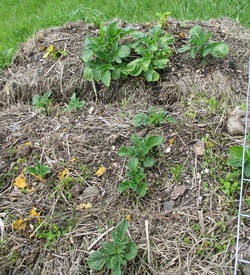 Baby potatoes sprouting up in the
Baby potatoes sprouting up in the seasoned bales,
A couple of weeks later, still too wet to dig in the actual dirt, I planted peas in another bale next to the potatoes, which were now starting to sprout up tentatively here and there, looking just fine. The peas popped up in about a week or so as well.
I then tried lettuce, salad mix, spinach and arugula. These proved trickier, however. I had added some compost on top of the bales to plant the fine seeds in, but apparently it wasn't enough - or I let the dirt dry out too much - still not sure what happened exactly.
After a couple of weeks of waiting with no results, I gave up, added a thicker layer of dirt on top, and re-planted. This time, I overdid it a bit, thinking the somewhat old seed may have been bad. The lettuce still came up somewhat poorly, but I ended up with a virtual forest of arugula - AND, on top of that, the first bale of arugula I had planted weeks ago came up, too! (The spinach never came up at all, even after 2 plantings of new seeds. Not sure why, except maybe I didn't get it deep enough.)
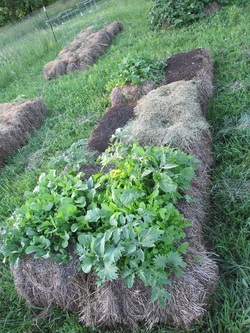 The lettuce & arugula forest!
The lettuce & arugula forest! The bales are now full - peppers, tomatoes, cantaloupe, and watermelons are occupying the rest, and I just planted summer squash and zucchini a few days ago in the last two.
While the weather has calmed down a bit, and I have sporadically been able to work on digging actual beds in the dirt (which is exhausting, frustrating work in the clay soil, usually always either too dry and hard as a rock, or too wet and glue-like - plus it has never been gardened before, and is full of well-established grass roots), we would barely even have a garden at all yet if we hadn't embarked on the hay-bale experiment!
For those interested in trying it, you can find a number of helpful resources on strawbale gardening on Amazon.com.
From my experience so far, here are the pros and cons I've found in our first season with a hay bale garden:
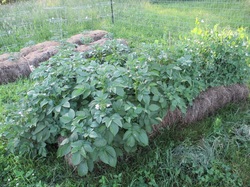 Potatoes & peas going crazy!
Potatoes & peas going crazy! - It couldn't be easier to build beds - just lay out your bales where you want them! I put thick layers of wet newspaper underneath first to try to kill out the grass/keep weeds from coming up through them. This may have helped a bit, but did not stop the weeds altogether (we have some tough vines and other plants that came right up through them - mostly between the bales, though).
- You can garden even when it's really wet - or flooded! Even if the bales are sitting in water, the top few inches are still plenty dry enough to plant no matter the weather.
- The bales are really warm. Partly due to the decomposition, and partly I guess to the heat of the sun on the raised bales, they are very warm inside, and stay warmer overnight, which helps you get an early start on the garden. That said, you will still have to cover sensitive plants. I lost several potato plants due to a late freeze, as I had not covered them heavily enough, figuring the bales would keep them warm. :-(
- They are pretty high, which makes it easier to weed, water, etc. This is proposed as one of the main advantages of straw bale gardening, but for me it doesn't make that much of a difference. You will still have to bend over to do all the regular garden things - just not quite as far. It is nice though, to just be able to weed out around the bales a little, and then mow between them. And it does help if using a watering can, as you're not splashing as much water everywhere, so you have more control over watering without having to bend down.
- Most plants I've planted in them seem very happy! I lost one tomato and one tiny pepper plant that wasn't in very good shape to start with. Otherwise, besides the frost-bitten potatoes, everything is growing like crazy!
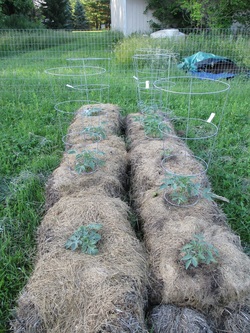
- They dry out. Fast. Even with all the rain we've had, I've had to water a number of times already, which is quite a chore since we don't have our rain tank set up yet, so there is no water source anywhere nearby, which means lugging full watering cans two by two all the way from the house. If we go more than 2 warm or hot sunny days with no rain, they need a good watering.
- Yes, they're weedy. For the most part, the weeds consist of grass, sprouting from the hay seeds. However, it has not been overwhelming to stay ahead of at all, and the grass pulls out really easily.
(We also have these horrible little wild morning glory vines that come up everywhere, but that's in the regular garden too, not just in the bales, so I can't blame them for that.)
- This is not so much a con as a caution, but if you plant fine seeds like lettuce in them, you will need to add a decent (inch or so) layer of soil and compost on top of the bales to plant in. Then you will have to water - a LOT - until they come up (think twice a day, if it doesn't rain), as the surface dries out so quickly because the hay underneath absorbs the water.
I put compost on all of the bales anyway to add nutrients to the hay, and it's best to do this a couple of weeks ahead of planting if possible so it can soak in. But additional soil was needed for the lettuce and arugula.
That's all I can think of in terms of cons right now - so far, we have been really happy that we gave this a try! I will give you an update on the whole season later in the year. The only concern I have right now is that some of the bales are really starting to decompose and even sink in a little, so I'm hoping they hold up okay for the heavier veggies like tomatoes....
Have you tried hay or straw bale gardening? If so, what was your experience?
I'd love to hear from you!
Rose.

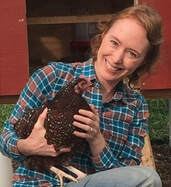

 RSS Feed
RSS Feed